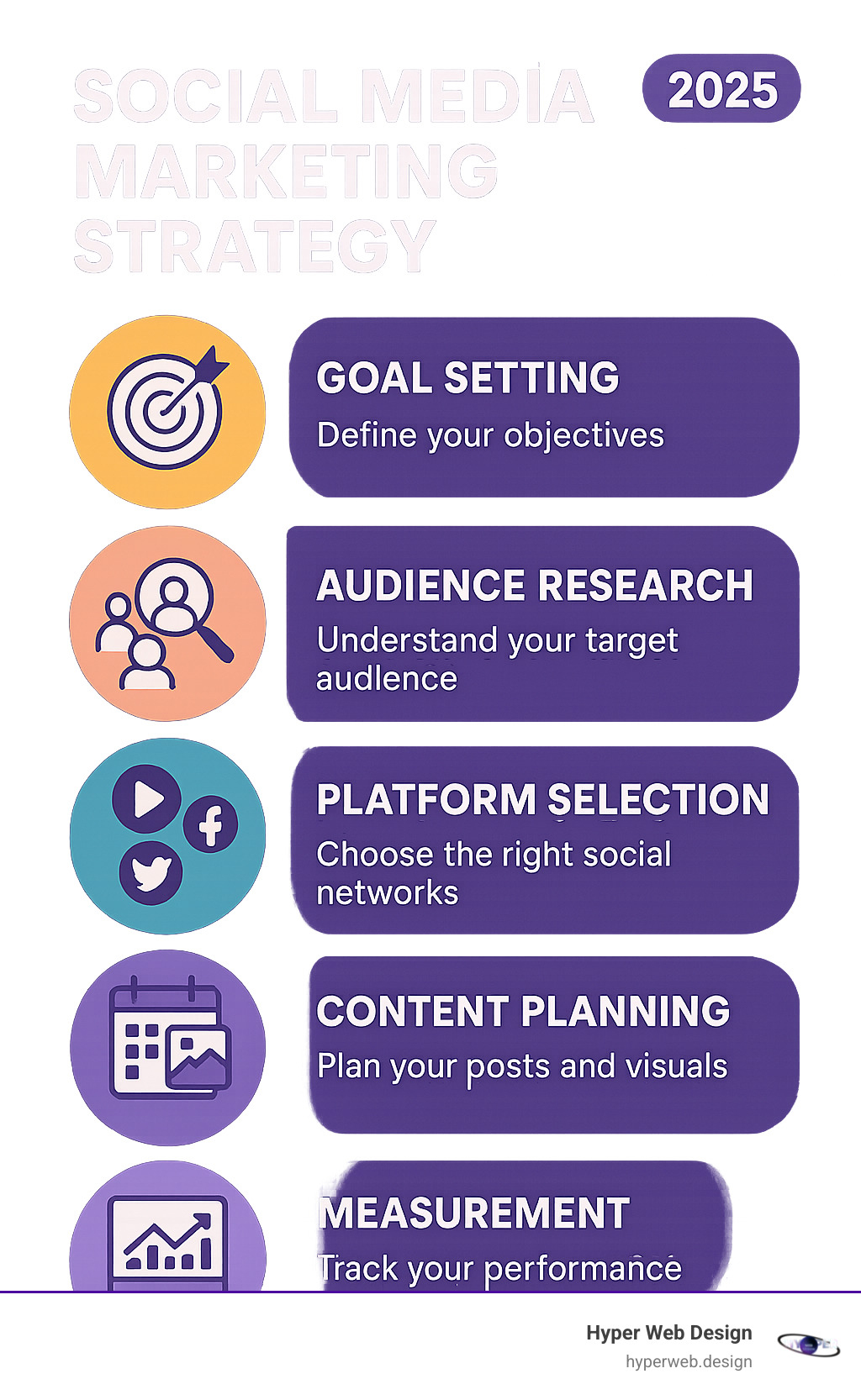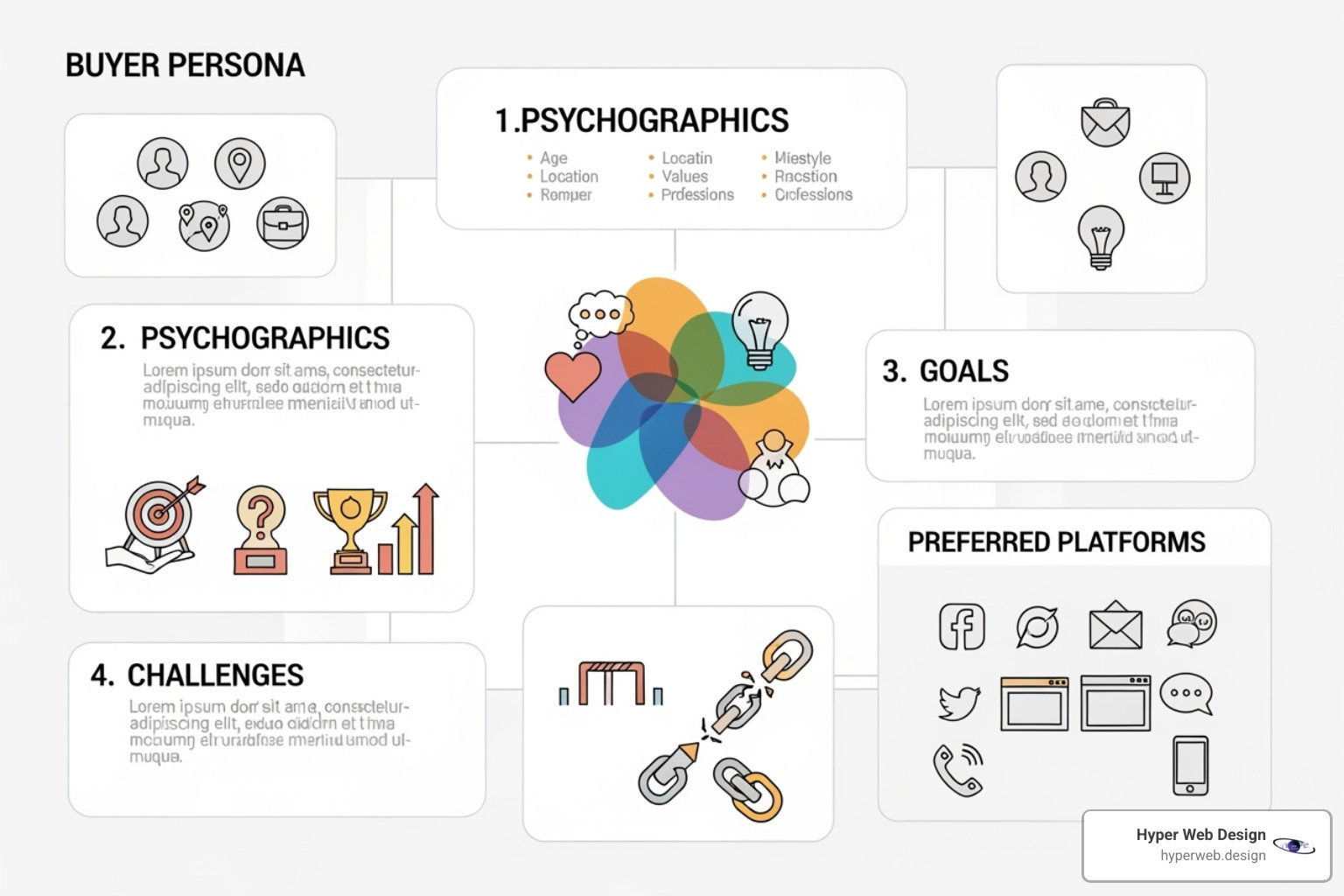How to Create a Social Media Marketing Strategy in 7 Steps
A social media marketing strategy is your business’s roadmap for online success. It involves defining goals, understanding your audience, choosing platforms, planning content, and measuring results. With over 4.74 billion people using social media daily, a clear strategy is no longer a trend; it’s a vital part of modern business.
An effective strategy turns your online presence into a powerful engine for growth. It helps you connect with your audience, build trust, and drive real business goals, turning effort into measurable impact. It’s how you move beyond just posting and start truly making your mark.
I’m Shawn Shameli. For over a decade, I’ve helped businesses craft visually engaging, highly optimized websites. My expertise extends to developing robust social media marketing strategy solutions that deliver real results for my clients.
Social media marketing strategy vocabulary:
Crafting a social media marketing strategy might seem daunting, but we’ve broken it down into a clear, actionable 7-step process. This is your blueprint for turning online activity into real business impact.
Step 1: Set SMART Goals for Your Social Media Marketing Strategy
Setting clear, measurable goals is the compass for your social media marketing strategy. Without them, you’re just posting into the void. We advise using the SMART framework:
- Specific: What exactly do you want to achieve? (e.g., “Increase Instagram followers by 20%”).
- Measurable: How will you track progress? (e.g., follower count, engagement rate).
- Attainable: Is the goal realistic given your resources and timeframe?
- Relevant: Does this social media goal align with your overall business objectives?
- Time-bound: When do you want to achieve this by? (e.g., “within the next six months”).
Common goals include:
- Brand Awareness: Getting more eyes on your brand. 79% of marketers prioritize this. We measure it through reach, impressions, and mentions.
- Lead Generation: Turning social media users into potential customers by driving traffic to a landing page or collecting email sign-ups.
- Website Traffic: Boosting visits to your SEO-optimized website, tracked via click-through rates (CTR).
- Sales Conversions: Directly selling products or services through social commerce or driving website purchases.
- Customer Service: Using social media to respond to inquiries and build loyalty.
To measure success, we define Key Performance Indicators (KPIs). These specific metrics tell us if we’re hitting our SMART goals. For brand awareness, KPIs might include follower growth and reach. For sales, we’ll look at conversion rates and Return on Investment (ROI). While 68% of marketers worry about ROI, a clear strategy makes its value provable.
Step 2: Identify and Understand Your Target Audience
Creating content without knowing your audience is ineffective. Understanding them is the bedrock of a successful social media marketing strategy.
We create detailed buyer personas, semi-fictional representations of your ideal customers based on data. We analyze:
- Demographics: Age, location, gender, income, education.
- Psychographics: Interests, values, lifestyle, personality.
- Pain Points: Challenges your brand can solve.
- Social Media Habits: Which platforms they use, what content they like, and when they’re active. For instance, 46% of Gen Z prefers searching on social media over traditional search engines, favoring platforms like TikTok and Instagram.
We gather these insights using social listening tools, platform analytics, customer surveys, and competitive analysis. This deep understanding allows us to tailor messaging, content, and platform choices to truly resonate with the right people.
Step 3: Choose the Right Social Media Platforms
You don’t have to be everywhere. The goal is to be present where your target audience spends their time and where your brand’s message can shine. We consider:
- Platform Demographics: Does the platform’s user base align with your target audience? LinkedIn is ideal for B2B, while TikTok and Instagram attract younger audiences.
- Content Strengths: Does the platform fit your content? Instagram is visual-first, YouTube is for long-form video, and X (formerly Twitter) is for real-time updates.
- Resource Allocation: Can you consistently create high-quality content for that platform? It’s better to master one or two platforms than to be spread too thin.
- Competitor Presence: Where are your competitors thriving? This offers clues and opportunities to differentiate.
Here’s a quick overview of popular platforms:
| Platform | Primary Focus | Typical Audience | Best For |
|---|---|---|---|
| Community, broad reach | All ages, strong community | Building brand communities, broad awareness, customer service, targeted ads, events. | |
| Visuals, short video | Younger demographics (Gen Z, Millennials) | High-quality imagery, short-form video (Reels), product showcasing, influencer marketing, lifestyle content. | |
| Professional networking | Professionals, B2B | Thought leadership, B2B marketing, recruitment, industry insights, networking with decision-makers. | |
| TikTok | Short-form video, trends | Gen Z, younger Millennials | Viral content, trend participation, entertainment, behind-the-scenes, rapid brand building, especially relevant for brands with a dynamic story to tell. |
| X | Real-time updates, news | Broad, news-oriented | Customer service, breaking news, direct communication, public relations, quick polls and discussions. |
| Visual findy, inspiration | Visual shoppers, hobbyists | Product catalogs, DIY, inspirational content, driving traffic to e-commerce sites, especially effective for brands with visually appealing products or services. | |
| YouTube | Long-form video, education | Broad, all ages | Tutorials, product reviews, brand storytelling, educational content, SEO benefits as the world’s second-largest search engine. |
We focus on where your audience is most active and where we can deliver value. For more, see our guide on Social Media Marketing for Beginners.
Step 4: Develop a Winning Content Mix
Your content is the heart of your social media marketing strategy. It’s how you connect, engage, and convert.
We develop a strategy around 3–5 content pillars—broad themes aligned with your brand and audience interests. For a luxury travel brand, pillars might be “Exclusive Destinations,” “Travel Tips,” and “Behind-the-Scenes Trips.”
A consistent brand voice and tone is paramount. Your voice is your brand’s personality (e.g., witty, authoritative), while tone is the emotion in specific messages. Authenticity inspires trust, which 86% of consumers value. We help define your voice so every post sounds unmistakably you.
We often use the 70-20-10 rule for content planning:
- 70% Inform, Educate, or Entertain: Value-driven content that builds trust.
- 20% Shared Content: Curated content from relevant sources.
- 10% Promotional: Direct calls to action and sales. Being overly promotional is a turn-off for 34% of consumers.
Video content is king. Viewers retain 95% of information from videos versus 10% from text. We incorporate dynamic video, from short-form Reels to long-form YouTube content.
We also encourage User-Generated Content (UGC)—original content from your customers. It’s authentic and builds trust. Finally, interactive content like polls and quizzes boosts engagement and provides valuable audience insights.
Step 5: Create a Content Calendar and Publishing Schedule
A content calendar provides a bird’s-eye view of your posting schedule, ensuring consistency and strategic alignment.
We define your posting frequency for each platform (e.g., Facebook 1–2/day, TikTok 1–4/day). The key is consistency. Posts with three to four hashtags often get the most impressions.
While general optimal posting times exist, we analyze your audience data to find when your followers are most active.
We use content batching—dedicating blocks of time to create similar content—to streamline the creative process. Scheduling tools automate posting, but we remain active for real-time engagement.
Finally, we ensure visual consistency across all posts, maintaining your brand’s luxury aesthetic with consistent fonts, colors, and logos to improve brand recognition.
Step 6: Engage With and Grow Your Community
Social media is a two-way street. A great social media marketing strategy prioritizes active engagement to foster genuine connections.
This means:
- Two-way Conversations: Responding promptly to comments and messages. 47% of US consumers favor brands that respond quickly to concerns.
- Customer Service: Using platforms like X for timely support, turning potential frustrations into loyalty.
- Building Relationships: Initiating conversations, running polls, and encouraging user-generated content to make your brand more human.
- Community Management: Participating in industry discussions and celebrating followers to become a valued community member.
Our dedicated social media manager ensures your brand is actively listening and responding, cultivating a loyal and engaged audience.
Step 7: Measure, Analyze, and Optimize Your Social Media Marketing Strategy
Even the best social media marketing strategy needs regular check-ups to understand what’s working and what isn’t. This is an iterative process of testing, learning, and refining.
We track KPIs that align with your SMART goals, focusing on more than just vanity metrics. Key metrics include:
- Engagement Rate: Interactions (likes, comments, shares) relative to your reach.
- Click-Through Rate (CTR): Clicks on your links to visit your website.
- Conversion Rate: The percentage of visitors who complete a desired action (e.g., purchase).
- Cost Per Lead (CPL) / Cost Per Click (CPC): Ad spend efficiency for paid campaigns.
- Return on Ad Spend (ROAS): Revenue generated per dollar spent on ads.
We use analytics tools and A/B testing to gather data and compare content performance. This continuous analysis informs our strategy refinement. If a content type excels, we do more of it. If a campaign underperforms, we pivot. Your strategy is a living document, constantly evolving to ensure your efforts translate into tangible business growth.
Advanced Tactics for Growth and Engagement
Beyond the basics, powerful tactics can be woven into your social media marketing strategy to accelerate growth and deepen audience connection. These are the ingredients that make your brand shine online.
Leverage Influencer Marketing
Influencer marketing involves partnering with trusted voices your audience already follows. The key is finding partners whose community is relevant and engaged with your brand. We work with both micro-influencers (smaller, highly engaged audiences) and macro-influencers (wider reach) to achieve campaign goals, from brand awareness to sales. Influencer campaigns can be 30% cheaper than traditional ads and are a budget-friendly way to build trust. We ensure all partnerships follow FTC guidelines for transparency.
Run Contests and Giveaways
Contests and giveaways are excellent for boosting engagement, gaining followers, and creating buzz. We start by defining a clear goal, such as lead generation or brand awareness. We then establish clear rules and promote the contest across all channels. Encouraging User-Generated Content (UGC) is a powerful tactic. For example, Coca-Cola’s ‘Share a Coke’ campaign, which encouraged customers to share photos of personalized bottles, created massive engagement and drove sales through authentic, customer-created content.
A well-designed giveaway post with clear instructions and an exciting prize can grab significant attention.
Harness the Power of Live Video and Social Commerce
Live video is a powerful tool in your social media marketing strategy for real-time connection. We use it for:
- Live Q&As: Build trust by answering audience questions directly.
- Behind-the-Scenes Tours: Show the human side of your brand.
- Product Demonstrations: Showcase features and answer questions instantly.
Live Shopping Events are the core of social commerce, allowing viewers to buy products directly within a live stream. This immersive experience is highly effective; live commerce can convert viewers into buyers at a rate of nearly 30%. Social media algorithms often boost live content, increasing your brand’s visibility and creating immediate, conversion-focused experiences.
Navigating Common Challenges and Pitfalls
Even the best social media marketing strategy can face challenges. Here’s how we steer common pitfalls to keep your brand on track.
- Negative Feedback: This is a natural part of being online. We view it as an opportunity. Responding quickly and professionally can turn an unhappy customer into a loyal fan.
- Algorithm Changes: Social media platforms constantly update their algorithms, affecting content visibility. Our approach is flexible; we monitor these changes and adjust your strategy to maintain visibility and relevance.
- Follower Fatigue: Posting only sales content or irrelevant information causes audiences to tune out. We prevent this by following the 70-20-10 rule, focusing on content that informs and entertains first.
- Inconsistent Branding: A disjointed voice or visual style can damage trust. We ensure every post on every platform reflects your high-end, luxury identity for consistent brand recognition.
- Being Too Promotional: Constantly pushing products is a turn-off for many users; 34% of people dislike overly self-promotional content. We strike a balance between valuable content and promotional messages to build relationships.
- Avoiding PR Crises: A single poorly-timed post can cause significant damage. Our strategy includes strict content review guidelines and a rapid-response plan to mitigate the risk of poorly timed posts.
- Measuring True Engagement: It’s easy to focus on “vanity metrics” like likes and followers. We concentrate on the Key Performance Indicators (KPIs) that reflect your actual business goals and Return on Investment (ROI).
Effective social media marketing requires thoughtful planning and dedicated effort. We guide your brand past these common traps to ensure you thrive in the dynamic world of social media.
Frequently Asked Questions about Social Media Strategy
Here are answers to some of the most common questions we hear when crafting a social media marketing strategy.
How often should I post on social media?
There’s no single answer, as the ideal frequency depends on your industry, audience, and platform. Our golden rule is consistency over frequency, and quality over quantity. It’s better to share high-quality content a few times a week than to post low-effort content daily.
We determine the right cadence by looking at platform-specific best practices (e.g., TikTok and X thrive on more frequent updates than LinkedIn) and analyzing your unique audience engagement patterns. Through continuous testing and analysis, we find the posting schedule that works best for your brand without overwhelming your followers.
How much should I budget for social media marketing?
The budget for a social media marketing strategy varies based on your business goals. Key components include scheduling tools, content creation costs (e.g., video production), paid advertising, and management services.
You can start small with organic content and basic tools, then scale up investments as your strategy proves its ROI. Paid social, in particular, is excellent for targeting ideal customers. Organic social media marketing services can range from $2,500 to $12,000+ per month, depending on the scope. Most importantly, your budget should directly align with your SMART goals. If sales conversion is a priority, we may allocate more to paid social to drive immediate results.
What are the most important metrics to track?
We focus on metrics that tie directly to your SMART goals, moving beyond “vanity metrics” like likes and follower counts. The metrics that truly measure business impact are:
- Engagement Rate: How many people interact with your content (likes, comments, shares) relative to its reach. High engagement means your content is resonating.
- Click-Through Rate (CTR): How many people click the links in your posts, which is vital for driving traffic to your website.
- Conversion Rate: The percentage of users who complete a desired action (e.g., make a purchase, fill out a form). This metric turns social media efforts into business results.
- Cost Per Click (CPC) / Cost Per Lead (CPL): These metrics measure the efficiency of your paid ad campaigns.
- Return on Ad Spend (ROAS): The revenue generated for every dollar spent on social media advertising.
Tracking these meaningful metrics allows us to demonstrate the true ROI of your social media marketing strategy.
Conclusion: Turn Your Strategy into Action
A solid social media marketing strategy is essential for success in today’s digital world. We’ve covered the seven vital steps: setting SMART goals, understanding your audience, choosing platforms, creating content, scheduling posts, engaging your community, and continuously measuring your efforts.
Your social media marketing strategy is a living document. The digital landscape is always evolving with new trends and algorithm shifts. Our approach is to stay nimble, accept continuous improvement, and ensure your brand remains relevant and engaging.
At Hyper Web Design, we specialize in crafting high-end, SEO-optimized websites for elite brands, blending luxury design with advanced technology. Our expertise extends to social media, where we help you drive not just engagement, but tangible business growth. We can transform your social media presence into a powerful asset for your brand.
Ready to make your mark? Let’s turn your social media goals into a vibrant reality.
Lift your brand with professional Social Media Marketing Services






